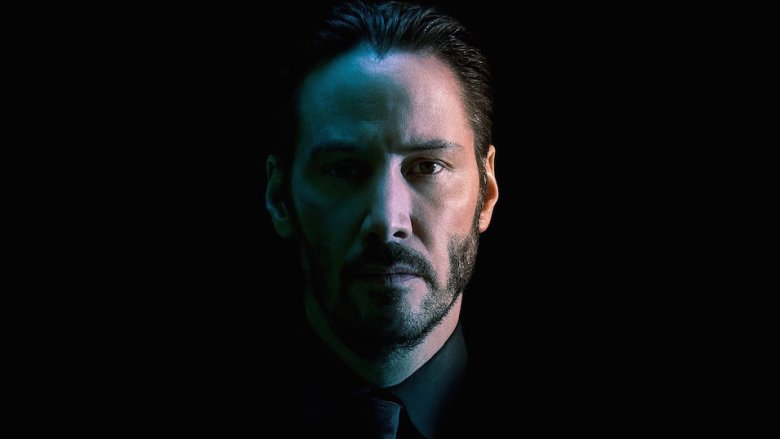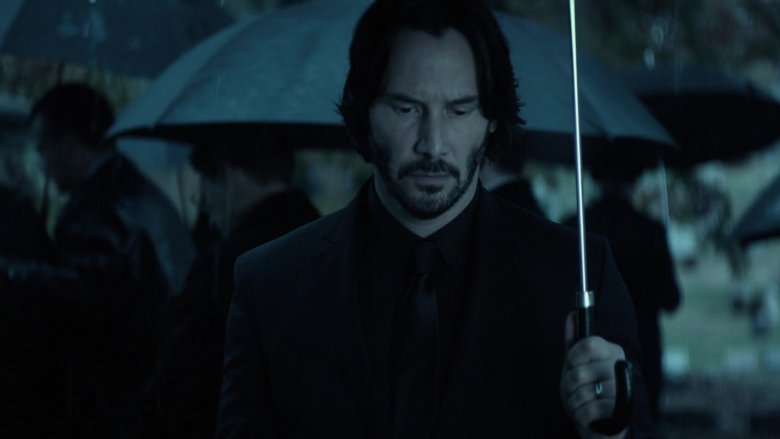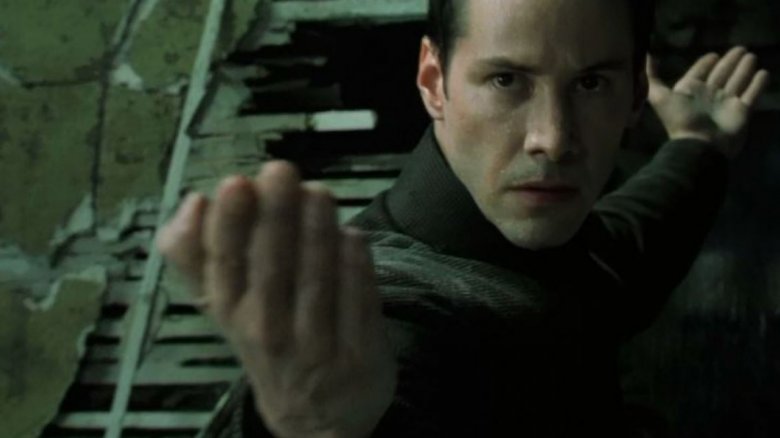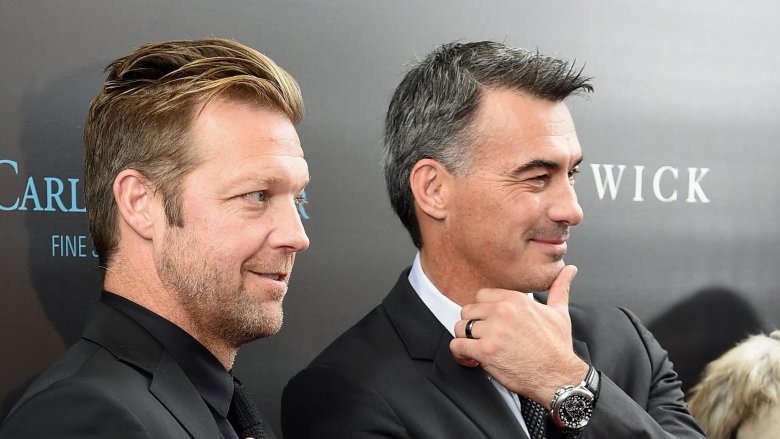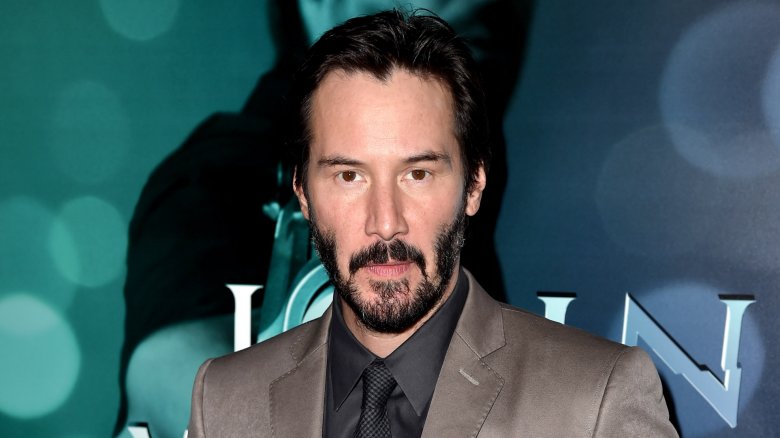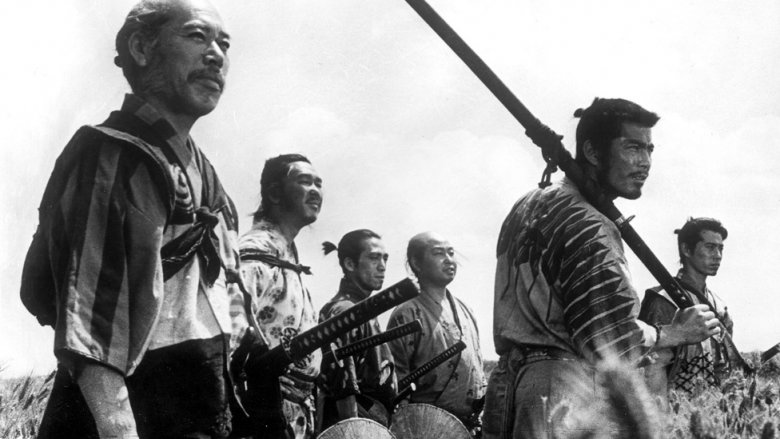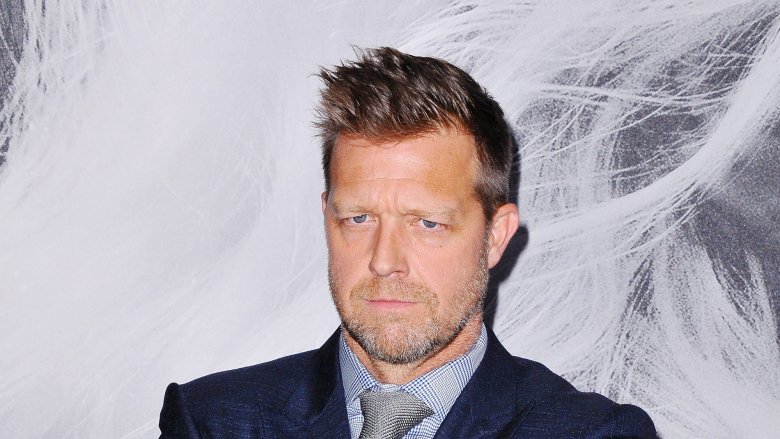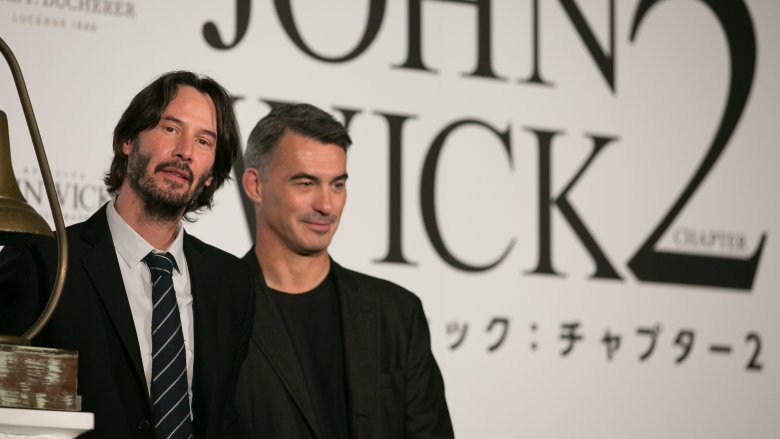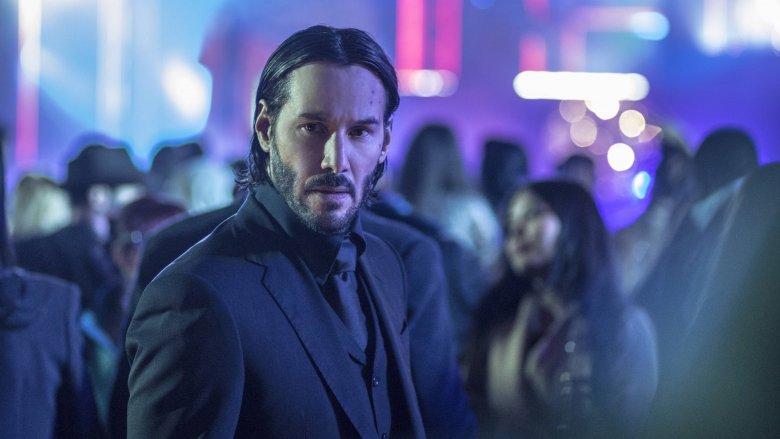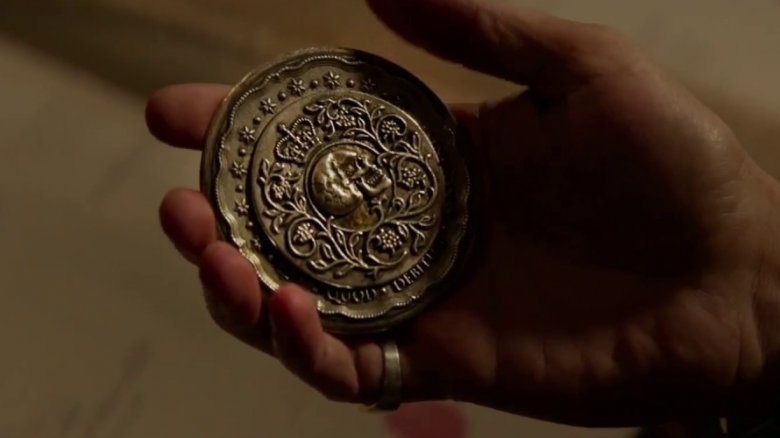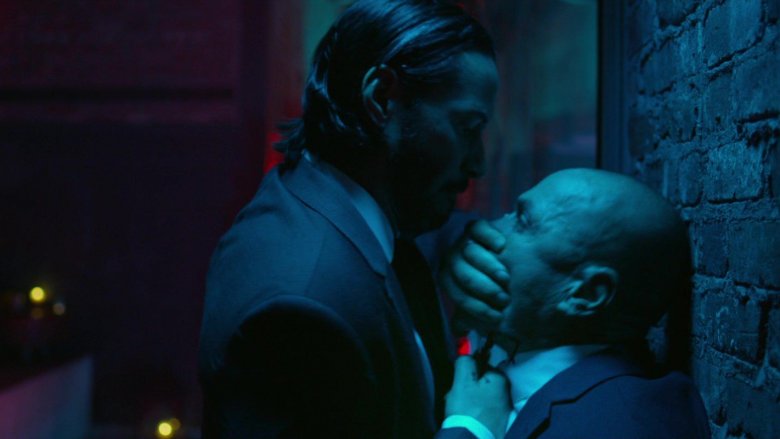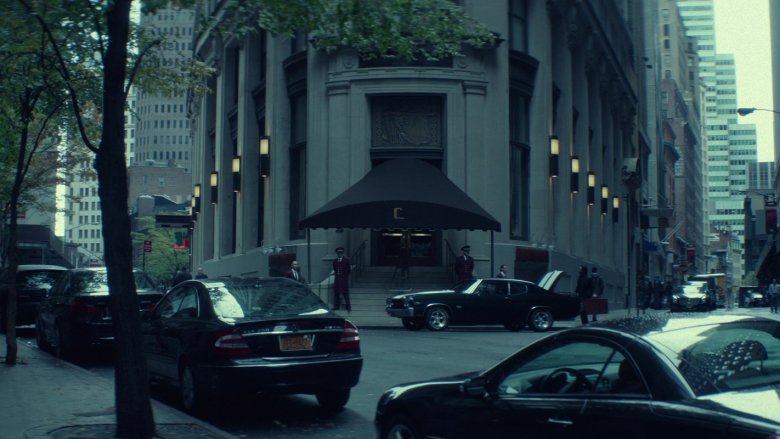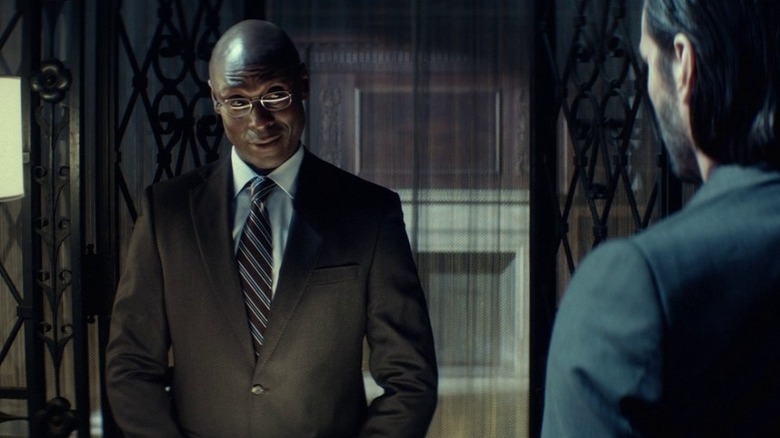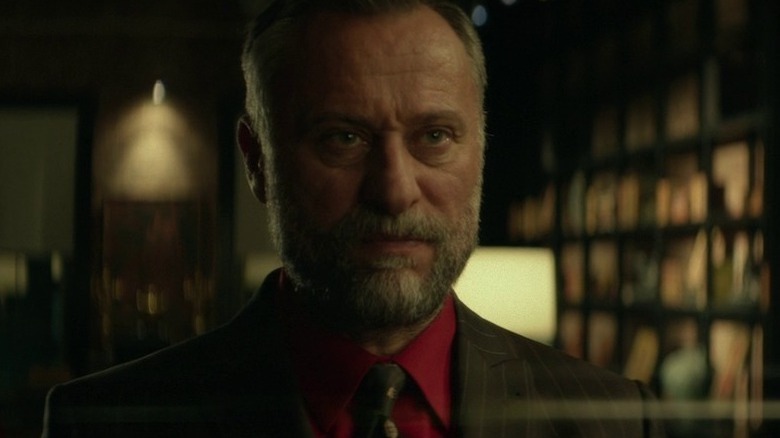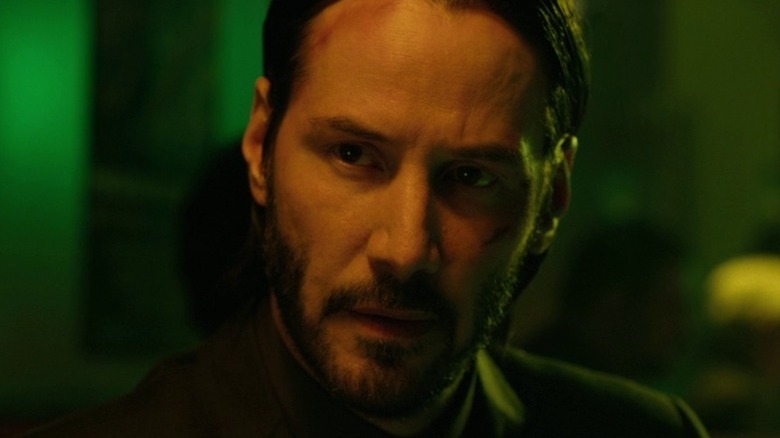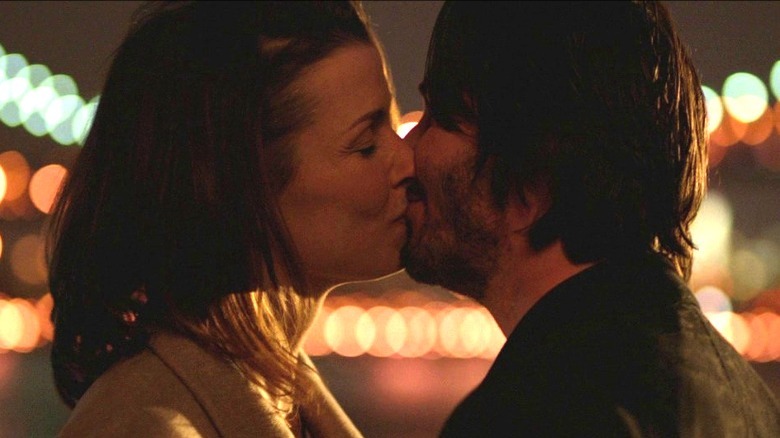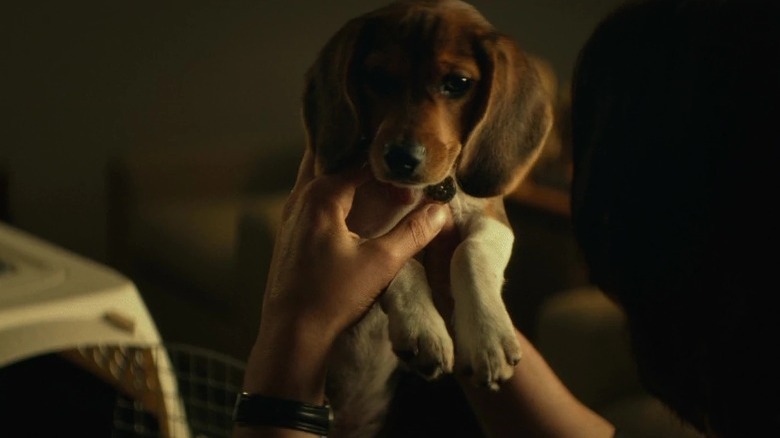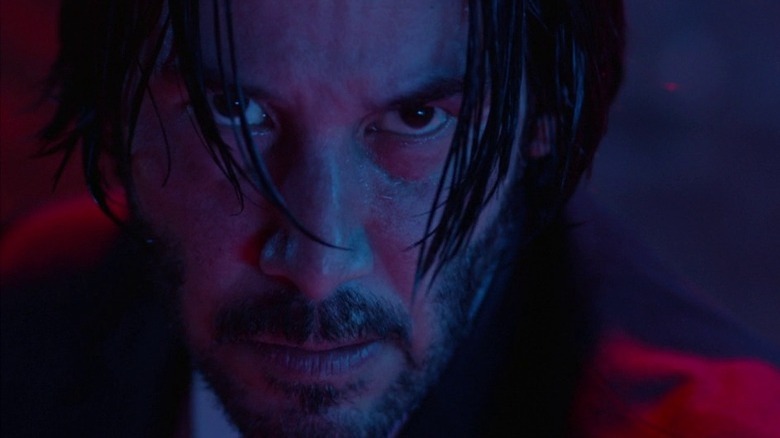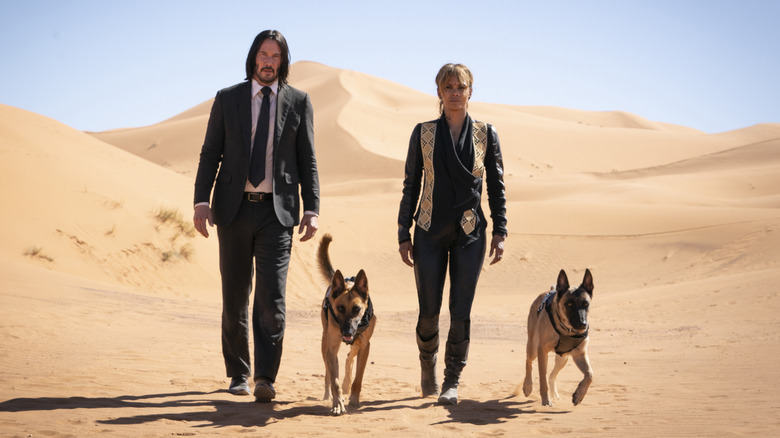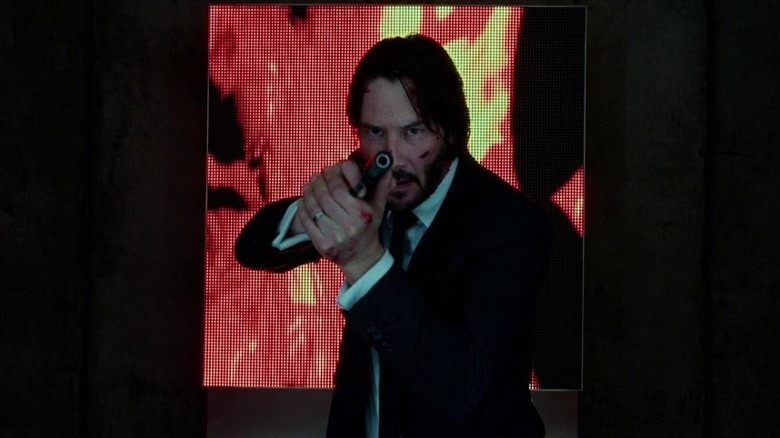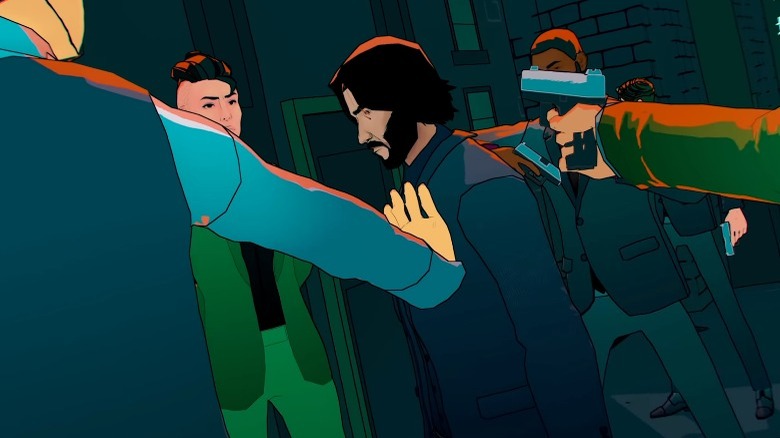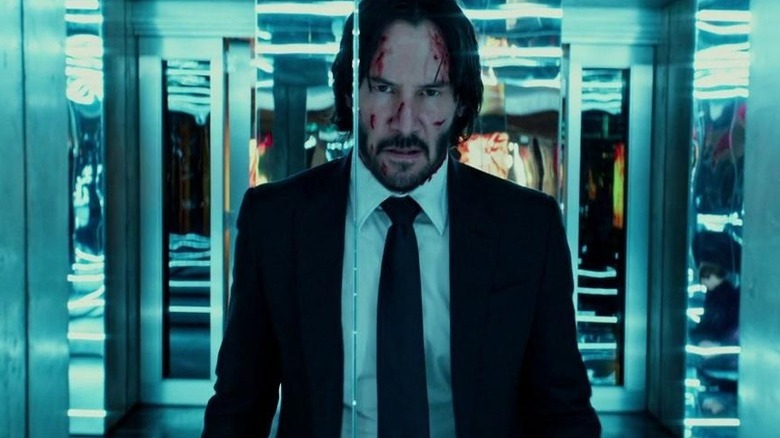22 John Wick Facts That Are Worth Fighting For
Thanks to its mind-bending action sequences, careful world-building, and beloved star, the "John Wick" franchise has become quite popular, performing admirably at the box office and faring well with both critics and fans. With Keanu Reeves starring as the deadly title character, these revenge thrillers have delighted viewers since the franchise started, and demand for further installments and spinoffs remains strong. Packed with unbelievable fight scenes and impeccable stunts, the "Wick" films have changed the face of action cinema, and their legacy will almost certainly impact action films and fight scenes for years to come.
Though hardcore fans may have seen the "John Wick" movies countless times and combed through them for references, fun facts, and more, the mysterious world of everyone's favorite dog-loving assassin still holds plenty of secrets. From "gun-fu" to surprise producers and more details on those mysterious coins, here are some facts you might not know about the "John Wick" series.
It's not an adaptation, but an original script
Thanks to the incredibly detailed world of the "John Wick" films, from Wick's intense backstory to the hotel that houses some of the world's most deadly assassins, many fans might assume that the first film was based on some kind of adapted source material, but "John Wick" was actually a completely original script. In 2012, writer Derek Kolstad developed the idea and started work on the spec script, originally entitled "Scorn," about a man who trafficked in evil and finally gets some sort of redemption only to lose it.
After a few studios showed interest, he sold it to Thunder Road Pictures because they promised to make the movie as soon as possible. Though Wick was originally written as a much older retired hitman, Kolstad revised the script once Thunder Road purchased the rights, making Wick younger and applying any changes the studio wanted (aided by Reeves, who also helped revise the script).
The film might not have been based on a comic book or video game, but the character of John Wick has now inspired works in both mediums — Dynamite Entertainment has since released a comic book series about Wick's origin story, and gamers can get into Wick's mindset by playing "John Wick Chronicles." Just before the first film was released, Wick also appeared as a playable character in "Payday 2," solidifying him as an action star even before his film debut. Wick is also purchasable and playable in "Fortnite."
It's deeply connected to The Matrix series
Keanu Reeves has appeared in plenty of famous films, but perhaps his most widely known role is that of Neo in the "Matrix" film series, a trilogy and universe that set new standards for action films as well as giving pop culture one of its best theories about alternate realities. As Neo, the mystical "One" who can control the synthetic world of the Matrix and fight the machines holding humans hostage within the Matrix and the real world, Reeves established himself as a true action star, making him the ideal choice to play one of the world's most lethal hitmen in "John Wick."
Beyond sharing a lead actor, the "Matrix" and "John Wick" film series have quite a lot in common, including the crew who worked on both films as well as a few other cast members. The two directors of the first film, David Leitch and Chad Stahelski, were stuntmen on "The Matrix," and Stahelski was actually Reeves' stuntman; the second chapter in the series, "John Wick: Chapter 2," reunited Reeves with Laurence Fishburne, who appeared as Neo's mentor Morpheus in "The Matrix." Diehard "Matrix" fans may have caught another cameo as well — Randall Duk Kim, who played the Keymaker in "The Matrix Reloaded," showed up as a doctor in the first "Wick" film.
Keanu Reeves chose the original directors himself
Keanu Reeves had plenty of input on the film, helping to shape his character and working closely with writer David Kolstad, who said Reeves was closely attuned to even the smallest details that could help flesh out his otherwise mysterious character. Keeping in mind Reeves' famously generous nature, it's no surprise that he turned to former crew members from "The Matrix" to help him create a great action film — specifically, David Leitch and Chad Stahelski.
Though Reeves initially reached out to the two veteran fight choreographers and stuntmen to see if they would simply design the film's action, he hoped they would direct, and luckily for Reeves, they were more than happy to take on the challenge. Having worked with Reeves plenty of times before, Leitch and Stahelski were familiar with both his prowess and his process, making stunts and fights on "Wick" that much more seamless. Both Leitch and Stahelski have credited their work on "The Matrix "as an inspiration for "John Wick," as well as a guiding light for their overall careers; Stahelski has said that not just "John Wick," but most films he's worked on as a stuntman wouldn't exist without the template of "The Matrix," and both directors have said that watching Lana and Lilly Wachowski, masterminds behind the "Matrix" films, was essentially a master class in directing action that maintained an emotional core.
Reeves does basically all his own stunts
Throughout his career, Reeves has gone from goofy comedies like "Bill & Ted's Excellent Adventure" to plenty of different action films, and he's now an experienced stuntman in his own right, learning countless forms of fighting and performing many of his own stunts throughout his storied career. "John Wick" is no exception.
To prepare for "Wick," Reeves spent months training with veterans from SWAT teams as well as former Navy SEALs, thanks to Leitch and Stahelski's insistence that the star not use any of his previous martial arts knowledge in the film and instead learn entirely new methods of fighting. Reeves went on to do a large amount of the stunts seen in "John Wick" (a tradition in his films) and most of them with no double in "John Wick 2," where the stunts and fights far surpassed the first film, upping the ante for Reeves as well as for loyal viewers. The 3rd "Wick" contained even more death-defying acts from Reeves, proving that even as he ages, he's still more than capable of stunning audiences with his stunt work — and a complete commitment to what has now become one of his signature roles.
A surprising producer
Celebrities produce blockbuster films more often than you might think. Some have even won Academy Awards for their production work — Brad Pitt earned an Oscar when "12 Years a Slave" (which he helped produce) won best picture, and both Ben Affleck and George Clooney picked up statues for "Argo" as producers, with Affleck also serving as director for the best picture winner.
Actors sidelining as producers isn't uncommon, in other words, but one of the producers on the first "Wick" films might still come as a surprise. According to the DVD commentary, Eva Longoria, best known for her role on "Desperate Housewives," is a credited producer; Leitch and Stahelski both noted that they've never met her, but they're grateful to her for "writing a check." Whether you knew it or not, fans have Longoria to thank for initially bankrolling one of Hollywood's most beloved recent action franchises.
Influences include spaghetti westerns, Kurosawa, and Clint Eastwood
Leitch and Stahelski obviously drew from their experience working on other action films, including "The Matrix," but "John Wick" also drew its unique tone from everything from classic action movies to horror novels. The two directors cited several direct influences on the film, which ranged from Clint Eastwood's classic Western "The Good, The Bad and the Ugly" to crime films like "Point Blank" and foreign releases like China's "The Killer" and France's "Le Cercle Rouge."
Interestingly, though the film certainly has a noir feel and could even be classified as neo-noir, the directors have also said that noir wasn't as strong of an influence, invoking spaghetti westerns and directors like Kurosawa instead (his name comes up quite frequently when the two discuss the first film in the series). Beyond Kurosawa, Leitch and Stahelski have also brought up names like Steve McQueen, Sergio Leone, and Burt Reynolds, looking to classic action stars and directors from the 1970s and 1980s for inspiration. As far as world-building goes, writer Derek Kolstad mentioned horror writer Stephen King as a huge influence, especially to show how far a broken man will go (a common theme in King's works), as well as Scottish novelist Alistair MacLean.
One of the original directors went on to other projects
Even though Stahelski and Leitch technically co-directed the first "John Wick" film, the Director's Guild of America ruled that only Stahelski could be credited as the director, while Leitch was listed among the film's producers. In any case, though the two clearly maintained a good professional relationship, they parted ways for the second film, and Stahelski went on to direct "John Wick: Chapter 2" as well as "John Wick: Chapter 3 – Parabellum" by himself.
Meanwhile, Leitch embarked on an incredibly lucrative career of his own — the same year Stahelski helmed "John Wick 2," Leitch directed "Atomic Blonde," an action thriller starring Charlize Theron that also became famous for its stylized action set pieces, particularly a one-take fight in a stairwell. After that, Leitch took the reins on "Deadpool 2," the second outing for Ryan Reynolds' foul-mouthed mercenary; he is attached to upcoming action films including a Fast & Furious spinoff and an adaptation of the popular video game "The Division," so his departure from "Wick" doesn't seem to have slowed the job prospects for this stuntman-turned-director one bit. He also stays in touch with Stahelski to help with ideas in an advisory role.
Stahelski wants the series to go on forever
It's fortunate for the "John Wick" series that they've been able to retain most of the creative team throughout all of the movies, especially director Chad Stahelski and writer Derek Kolstad, both of whom have been working on Wick since the very beginning. Between the comic books and video games, as well as upcoming spinoffs set within the world, it's clear that there's plenty of material to mine from the "John Wick" universe, and Stahelski, along with plenty of audience members, hopes that the series goes on for quite some time.
"I enjoy making these movies because there's no limit. We create our own mythology, and we have a studio that both stays out of our way and supports us on the wacky decisions," said Stahelski, also noting that he and Reeves, who is heavily responsible for the mythology of his character, have "ideas for days" and that he would happily spend the rest of his career existing within John Wick's dangerous, violent world. Considering the success Stahelski has enjoyed with the "Wick" franchise thus far, it's certainly understandable that he'd be content to keep telling this seemingly endless story.
The world-building is incredibly precise
One of the many things that fans love about the "Wick" series is the careful and detailed world in which the main character lives and kills, which is full of small details without being obvious or clichéd. Throughout most of the first film, audiences are actually unaware of Wick's past until other criminals realize that one of the most dangerous hitmen alive is coming out of "retirement," and it isn't until he returns to the Continental, the heart of this underground world, to begin seeking his revenge, that the world-building truly begins in earnest.
In a 2017 interview with Honest Trailers & Screen Junkies, Leitch and Stahelski divulged plenty of details about the world of the film, including little ones that fans may not have caught during a casual viewing. One such detail is that no "innocents" die in the "John Wick" series, which includes police officers — and not only are police officers spared by the assassins, they have their own underground which works in tandem with the criminal underground, and each side essentially leaves the other alone to do their job. All in all, it's pretty sophisticated for a worldwide crime syndicate responsible for brutal murders.
There are a lot of rules regarding the coins
Yet another perfect example of world-building in the "John Wick" series is the use of its coins, which hitmen like Wick can use as currency for everything from a hotel room to a well-stirred cocktail or a closet full of machine guns. Since these prices seem fairly inconsistent, to say the least, fans have worked tirelessly to try and figure out exactly how the gold coin-based economy actually works within John Wick's criminal underground, and some experts have even weighed in to say that this is fairly realistic when it comes to organized crime. Others have speculated that by pricing everything at the same point, the Continental prevents assassins from overstaying their welcome at the hotel, forcing them to use it as a simple stop during their missions.
As far as the directors are concerned, their view is that while the pricing is all over the place, it also doesn't matter, because that's not really what the coins are about — Leitch and Stahelski have said that they're essentially "business cards" that allow point of entry as well as indicating that the coin-holder is "in the know." Wondering about the currency value is, ultimately, missing the point. It's about the custom, not about getting change back for your Negroni or closet full of AK-47s.
The films are a genre some call gun-fu
Overall, the "John Wick" films are difficult to categorize — they're an odd hybrid of noir, spaghetti westerns, crime thrillers, action movies, and several other genres that seem like they might not blend seamlessly. However, the franchise can actually be categorized within a very specific genre called "gun-fu," which can be traced back to the films of John Woo, among others.
Taking the balletic approach of classic kung-fu movies, including more modern iterations featuring actors like Jackie Chan and Bruce Lee, Woo introduced guns into the mix with films like "Hard Boiled," which, in particular, is famous for a three-minute fight scene regarded as one of the best ever shot. The Wachowskis were the next directors to employ "gun-fu," making gunfights an elegantly shot affair that elevated a typical action sequence; crucially, "The Matrix" used famed choreographer Yuen Woo-ping, who went on to help choreograph other homages to the kung-fu genre, including "Kill Bill." In 2002, the little-seen Christian Bale movie "Equilibrium" also served up intense action scenes with a side of gun-fu. "John Wick" is among a new group of films joining the genre, using the weapons as props in highly stylized sequences and creating stylized, optically gorgeous set pieces to please audiences.
The universe will continue in an upcoming TV series
The hotel in the films, the Continental, is shrouded in mystery, despite its few yet clear rules (you can't kill on the grounds, you must use their signature gold coins as currency), and naturally, fans want to know as much about this criminal-ridden way station as possible. The minds behind the "Wick" films, including Reeves, are working on a new part of the "Wick" world that might explain some long-standing mysteries about the hotel, its guests, and its history.
In early 2018, it was announced that Starz would be developing a television series based on the universe called "The Continental" which plans to, naturally, focus on the hotel. Keanu Reeves will be an executive producer on the project, and executives from the network have told fans they shouldn't rule out seeing him appear on the show as well. Writer Derek Kolstad will be working on the show alongside Leitch and Stahelski, lending added credibility to this already exciting project.
Charon highlights the mythological ties
The "John Wick" franchise makes some obvious nods to classic action and martial arts movies, but the films also finds inspiration in Greek mythology. "You know, we've always seen John as Odysseus," series director Chad Stahelski told Variety in 2022, invoking the Greek hero who left home for the Trojan War and didn't find his way home for 20 years. Like Odysseus, John has found himself going more than a bit off course, and his adventures have put him in contact with other big, mythological figures.
Charon (Lance Riddick) works the front desk of the Continental, and he has a knack for finding whatever the hotel guests need, be it high-powered weaponry or a discreet doctor. Charon's name comes straight from mythology, but there are other similarities between him and his Greek ferryman equivalent. Both Charons help people travel through the seedy underbelly of the world, and both accept gold coins as payment for their services. Much like his mythological counterpart, Charon in the "John Wick" series is a man of few words and many secrets. How did he come to be part of John's world of assassins? With any luck, it's a topic to be addressed in a future movie or spin-off.
Viggo's hat wasn't just a fashion statement
With so many epic stunts and intense fight scenes, filming any high-octane action movie can be potentially dangerous, but what happened to actor Michael Nyqvist is on another level.
Nyqvist played Viggo Tarasov in the original "John Wick" film. He's the man who let John walk out of the world of assassins, and he's also the father of Iosef (Alfie Allen), the man who killed John's dog.
From his imposing presence to his sense of fashion, Viggo is a Russian mobster through and through, but the hat he wears in some scenes may have been less about showing off his style than covering up the aftermath of a terrible on-set injury. While working on the movie, Nyqvist accidentally got knocked into a window frame. His head hit the frame so hard that he nearly lost his ear and had to be rushed to a plastic surgeon. It took 80 stitches to put Nyqvist back together, and through the whole experience he really thought he was about to die. Luckily, he was just fine, and the hat his character wore in the film concealed the stitches while his injury healed.
John was named after the screenwriter's grandfather
The "John Wick" franchise wouldn't be what it is today without a massive team of talented people working together, but the story itself wouldn't exist without Derek Kolstad. Before 2014's "John Wick" changed his career forever, Kolstad had spent years grinding his way through Hollywood, trying to make it as a screenwriter. His earliest films include "One in the Chamber" and "The Package," but selling those did nothing to prepare Kolstad for the success of "John Wick."
The screenplay started out as a film called "Scorn," but that changed pretty quickly after Keanu Reeves signed on to play the lead. He convinced Kolstad to change not just the film's title, but also the name of its main character. John Wick is an undeniably cool name, but Reeves and Kolstad didn't come up with it at random. It's actually the name of Kolstad's grandfather who, the writer says, ironically has never seen any of the films. Fans of the franchise appreciate his contribution nonetheless.
Bridget Moynahan didn't read the full script
In many ways, Bridget Moynahan played the most important character in "John Wick," yet her appearance in the movie is so brief it's easy to overlook. She played John's wife Helen, the moral compass behind so much of his conflict in the films, and all these years later there's still very little that fans know about the character. How did she and John meet? Did she know anything about John's life before they got together?
While there aren't any definitive answers to those questions, Moynahan herself may have dropped a hint back when the first movie came out. In a behind the scenes interview, Moynahan talked about the things she did, and more important didn't do, to prepare for her role. The actress said that she didn't read any of the script beyond her own scenes. She didn't want to know about the violence John is capable of, because she thought it would get in the way of her helping Reeves portray a John who had left his past behind.
Of course, just because Moynahan was oblivious to how violent the films would be, that doesn't mean her character Helen was really in the dark. She might not have realized the full extent of John's brutality, but it's hard to imagine that she didn't know anything. After all, they had a cache of weaponry buried beneath the cement basement of their home.
Daisy the beagle is the real star of the show
How do you get an audience to root for a merciless hitman? Aside from casting Keanu Reeves in the role, the first "John Wick" movie solved the problem by giving its leading man an adorable costar.
John's wife, the story tells us, left him Daisy the beagle after she died. She hoped that by having something to love and care for, John would be able to hold on to the quiet, peaceful life that the two of them had built together. John and Daisy have an immediate connection, but some behind the scenes magic went into making that relationship feel genuine. Reeves had bacon grease smeared on his face so the puppy wouldn't be able to resist jumping on him and licking him.
What happened to the puppy after "John Wick" wrapped is just as sweet. His name was Andy, and for a while he lived at the Animal Actors International farm, but he was too cute to stay there for long. Eventually, a family adopted Andy and renamed him "Wick," so he'll always have a close tie to the movie that made him a star.
The flu can't keep Keanu down
There are few actors as dedicated to their work as Keanu Reeves. It's no secret that he does most of his own stunts, and that doesn't just apply to his work in the "John Wick" franchise. When he was filming "The Matrix Resurrections" he jumped off a building almost two dozen times to get the perfect shot for the film.
Reeves is well into his fifties now, but that hasn't stopped him from learning intricate martial arts maneuvers or moving through lengthy fight sequences like someone half his age. When working on the original "John Wick" in particular, Reeves went above and beyond what was being asked of him.
One of the film's most complicated scenes involves John battling through an entire night club full of baddies. In the director's commentary on the film, Stahelski lets it slip that Reeves had the flu while they were working on that particular scene. Reeves apparently had a 103 degree fever over the two days it took to put the entire night club sequence together. Even though people urged him to stop and take a break, Reeves refused, pushing his way through shot after shot of what became the film's most successful action set piece.
Halle Berry fought through broken ribs
Apparently, working on a "Wick" film brings intense energy out of everyone. Halle Berry joined John's world of underground assassins in 2019's "John Wick: Chapter 3 — Parabellum" as Sofia Al-Azwar, a professional killer with a lengthy shared history with Wick, as well as a team of some terrifying trained dogs.
Like Keanu Reeves, Berry went all in when it came to training for the film. She went through a quasi-hitman boot camp, learning a wide range of fighting techniques, gun skills, and animal handling tips in order to bring Sofia to life. The Oscar winner also learned some demanding choreography for her scenes, and during those hours of training and fighting, Berry broke three ribs. Her biggest concern, however, was that taking time to heal would cause her part to be recast. Fortunately for all involved, the "Wick" team waited for Berry to get back into fighting shape, and she was able to go on to become one of the most memorable supporting talents in the entire franchise.
The spin-offs are just getting started
Keanu Reeves may be the face of the "John Wick" franchise, but over the years diehard fans have become just as attached to the unique world and mythology of the series as they have to its main character. For anyone who's supremely interested in the deeper workings of the assassin underground, there's never been a better time to be a "John Wick" fan.
The spin-off show "The Continental" will act as a prequel to the first film while also bringing the world of "John Wick" into a new medium. There's enough going on at New York's premier hotel for assassins to likely fuel multiple seasons of television, but the franchise is also planning an expanded presence on the big screen as well.
The "John Wick" spin-off movie "Ballerina" is still something of a mystery, but it is known that the film will take a deeper look at the murderous ballet troupe introduced in "John Wick: Chapter 3." Ana De Armas will star as Rooney Brown, a trained killer now seeking revenge on the people who killed her family. John Wick will also be making an appearance in the film, but how he factors into the plot — or how this movie will impact his own story — remains a mystery.
Video games could be right around the corner
If you've ever watched a "John Wick" movie and wished you could be part of the action, you're not alone. Every movie in the series has the hallmarks of a great game — henchmen, a boss level, wild shootouts — but sadly, gamers have had few opportunities to try out some gun-fu for themselves.
"John Wick: Hex" is the only game thus far that has attempted to deliver the experience of becoming everyone's favorite gun-slinging hitman. Developed by Bithell Games, "Hex" is a top-down tactical strategy game that has players leading John through one group of armed guards after another. Because it's a strategy game, "Hex" moves a bit slower than a typical "John Wick" action scene, however, and ultimately just doesn't quite manage to translate John's experience into a playable format.
Luckily, there's still a strong possibility that fans are going to get the "John Wick" game they deserve. During an earnings call in late 2022, Lionsgate CEO Jon Feltheimer indicated that the company is very interested in producing a major AAA game based on "John Wick." There are no concrete plans for a game yet, but the company is interested in finding a developer. Considering how many more "John Wick" spin-offs Lionsgate has in the works, the company clearly isn't slowing down with the franchise anytime soon.
Keanu's training regimen has changed
Keanu Reeves has been an action star for a long time. He first learned kung fu as Neo in "The Matrix" in 1999, but almost a decade before that he was jumping out of a plane as undercover FBI agent (and ex-college football star) Johnny Utah. The man knows how to throw a punch and perform a stunt, but even more importantly, he knows how to train and take care of himself while learning new moves.
Understandably, Reeves has needed to adapt the way he trains as the years have progressed. In the lead up to "The Matrix," Reeves suffered a back injury and had to have his spine fused. He was still recovering while filming, and in some behind the scenes footage he's fighting while wearing a neck brace.
Today, Reeves doesn't have to contend with such a serious injury, and he's all but perfected his own physical training program. He told USA Today in 2014 that he's got a pretty simple secret to keeping his body in fighting condition. "You take really cold ice baths every night," he said.
